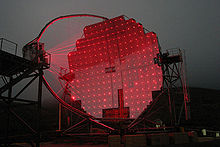
Very-high-energy gamma ray (VHEGR) denotes gamma radiation with photon energies of 100 GeV (gigaelectronvolt) to 100 TeV (teraelectronvolt), i.e., 1011 to 1014 electronvolts.[1] This is approximately equal to wavelengths between 10−17 and 10−20 meters, or frequencies of 2 × 1025 to 2 × 1028 Hz. Such energy levels have been detected from emissions from astronomical sources such as some binary star systems containing a compact object.[1] For example, radiation emitted from Cygnus X-3 has been measured at ranges from GeV to exaelectronvolt-levels.[1] Other astronomical sources include BL Lacertae,[2] 3C 66A[3] Markarian 421 and Markarian 501.[4] Various other sources exist that are not associated with known bodies. For example, the H.E.S.S. catalog contained 64 sources in November 2011.[5]
- ^ a b c Ikhsanov, N. R. (October 1991), "Particle acceleration and main parameters of ultra-high energy gamma-ray binaries", Astrophysics and Space Science, 184 (2): 297–311, Bibcode:1991Ap&SS.184..297I, doi:10.1007/BF00642978, ISSN 0004-640X, S2CID 122089313
- ^ Neshpor, Yu I.; N. N. Chalenko; A. A. Stepanian; O. R. Kalekin; N. A. Jogolev; V. P. Fomin; V. G. Shitov (2001). "BL Lac: A new ultrahigh-energy gamma-ray source". Astronomy Reports. 45 (4): 249–254. arXiv:astro-ph/0111448. Bibcode:2001ARep...45..249N. doi:10.1134/1.1361316. S2CID 118955434.
- ^ Neshpor, Yu I.; A. A. Stepanyan; O. P. Kalekin; V. P. Fomin; N. N. Chalenko; V. G. Shitov (March 1998). "Blazar 3C 66A: Another extragalactic source of ultra-high-energy gamma-ray photons". Astronomy Letters. 24 (2): 134–138. Bibcode:1998AstL...24..134N.
- ^ "Astrophysics with H.E.S.S." Retrieved 26 November 2011.
- ^ "The H.E.S.S. Source Catalog". H.E.S.S. Collaboration. 2011. Retrieved 26 November 2011.
© MMXXIII Rich X Search. We shall prevail. All rights reserved. Rich X Search
